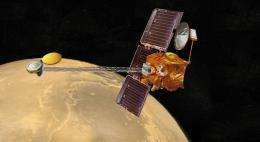Artist concept of NASA's Mars Odyssey orbiter. Image credit: NASA/JPL
(PhysOrg.com) -- From May 17 to 21, NASA's Mars Odyssey orbiter will conduct a fourth and final campaign to check on whether the Phoenix Mars Lander has come back to life.
During that period, Odyssey will listen for a signal from Phoenix during 61 flights over the lander's site on far-northern Mars. The orbiter detected no transmission from the lander in earlier campaigns totaling 150 overflights in January, February and April.
In 2008, Phoenix completed its three-month mission studying Martian ice, soil and atmosphere. The lander worked for five months before reduced sunlight caused energy to become insufficient to keep the lander functioning. The solar-powered robot was not designed to survive through the dark and cold conditions of a Martian arctic winter. However, in case it did, NASA has used Odyssey to listen for the signals that Phoenix would transmit if abundant spring sunshine revived the lander.
Northern Mars will experience its maximum-sunshine day, the summer solstice, on May 12 (Eastern Time; May 13, Universal Time), so the sun will be higher in the sky above Phoenix during the fourth listening campaign than during any of the prior ones. Still, expectations of hearing from the lander remain low.
"To be thorough, we decided to conduct this final session around the time of the summer solstice, during the best thermal and power conditions for Phoenix," said Chad Edwards, chief telecommunications engineer for the Mars Exploration Program at NASA's Jet Propulsion Laboratory, Pasadena, Calif.
Provided by JPL/NASA
























